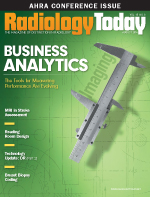 August 2014
August 2014
Quantitative Imaging Tools
By David Yeager
Radiology Today
Vol. 15 No. 8 P. 6
As medical imaging evolves, the constantly improving images offer more clinical information than ever before. For example, the capturing of numeric data that quantify the dimensions of structures seen on images, such as lesions, can be useful to referring clinicians. However, tools for gathering and translating these data for clinical purposes can be difficult to find because they aren’t widely available.
Despite the difficulties, tools that provide quantitative measurements will become increasingly important for patient care as value-based care takes hold. Bradley J. Erickson, MD, PhD, a radiologist at the Mayo Clinic, says radiology, as a specialty, is only beginning to tap the potential of quantitative measurements. He spoke at the 2014 Society for Imaging Informatics in Medicine (SIIM) annual meeting about their value and why radiology needs to look at them more closely.
“Increasingly, physicians are being pushed to make decisions or to prove the validity of their decisions based on numbers. If we in radiology don’t help them by supplying quantitative data about what’s happening in their patients, then our value is less than what it could be,” he says. “I think quantitative imaging is an important part of that value equation.”
What It Takes
The most common radiology measurements are for tumors, such as the Response Evaluation Criteria in Solid Tumors measurement, but most of these only measure one dimension, although there are some multidimensional measurements for vascular imaging and one for epilepsy. Erickson says the reason most measurements are done in one dimension is because they’re easier to interpret. He adds that tools that measure multiple dimensions generally aren’t user friendly, and a lack of tools that make good measurements relatively quickly is a significant barrier to their clinical adoption.
Another barrier is the amount of work involved in developing a quantitative measurement tool. For each measurement, the tool has to be validated before it can be implemented into a PACS. Erickson says the good news is that government institutions, such as the National Institutes of Health, and medical societies, including RSNA, are beginning to focus more on quantitative imaging. He believes this increased attention will help drive validation efforts.
Better reporting is necessary as well. Erickson says there’s relatively little structured data available, which makes reporting difficult. Although there has been some work done with ultrasound scanners recording obstetric results in the DICOM Structured Report format, which can be directly reported to a RIS, work of that nature is in its very early stages. Usually, the radiologist has to dictate the results into the RIS, increasing the possibility of speech recognition and formatting errors.
“Each of these measures is relatively unique in the nature of the tool that’s required and then also in the nature of the reports. For instance, in the case of the epilepsy tool, there isn’t a DICOM Structured Report template that explains what the number means,” Erickson says. “The measurements typically are made on the images, but the measurements are usually part of the interpretation, which is in the RIS, and there’s no good mechanism to transfer the measurements from the PACS into the text part of the report.”
Standard formatting also would make it easier for vendors to add these tools to their offerings. DICOM SR is one possible format; Annotation and Image Markup is another. Erickson says the radiology community needs to decide which of these methods is most useful and develop accompanying templates. He believes SIIM may take the lead on this issue.
Improving Patient Care
Difficulties aside, providing referrers quantitative results offers more detailed information and will increase the personalization of medical treatment. Erickson sees quantitation as a significant step in the process. “If you talk about something like an endovascular stent graft, it clearly is personalized. A stent graft that would work in you won’t work in me. So that absolutely is a great example of personalized medicine, down to the individual, as opposed to genomics, where they’re still talking about groups of people who carry a specific gene,” he says. “I think imaging is even more personalized, and I definitely think that we’re moving forward on that.”
Quantitative imaging also will allow clinicians to develop a deeper understanding of what disease looks like, how it behaves in the body, and how to treat it. Erickson says the definition of knowledge that Robert Kiyosaki puts forth in his book Rich Dad, Poor Dad—the ability to make distinctions—describes quantitative imaging’s potential well. He says clinicians will be able to use quantitative imaging tools to make ever more subtle distinctions between sets of medical image data.
“When I went through training, everything was visual, and you could identify fairly obvious findings,” Erickson says. “But with the example that I gave of epilepsy, a lot of those measurements could indicate differences that are so subtle that you just can’t perceive them with the eye, and I think that’s another advance that quantitative imaging will bring.”
— David Yeager is a freelance writer and editor based in Royersford, Pennsylvania. He writes primarily about imaging IT for Radiology Today.

